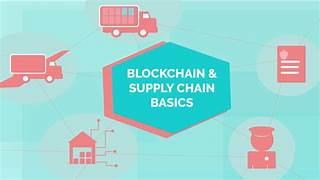How Can Blockchain Make Supply Chain Transparent?
Supply chains are the lifeblood of global trade, connecting manufacturers, suppliers, distributors, and consumers. Yet, traditional supply chain systems often suffer from a lack of transparency, inefficiency, and vulnerabilities to fraud or errors. Enter blockchain technology—a revolutionary tool that can enhance visibility, traceability, and trust across the supply chain.
This article explores how blockchain can bring unprecedented transparency to supply chains, its practical applications, and the challenges businesses face in adopting this transformative technology.
Understanding Blockchain and Its Core Principles
Blockchain is a distributed ledger technology that records transactions across multiple systems in a way that ensures security, transparency, and immutability. Each record, or “block,” is linked to the previous one, forming a secure and verifiable chain of data. Key characteristics of blockchain include:
- Decentralization: Data is stored across a network of computers rather than a central server.
- Immutability: Once data is added to the blockchain, it cannot be altered or deleted.
- Transparency: All participants in the network can view the same information in real-time.
These features make blockchain particularly suited for addressing the complexities of modern supply chains.
Challenges in Traditional Supply Chains
Traditional supply chains are plagued by several issues, including:
- Lack of Transparency
- Limited visibility into the origins and journey of products.
- Difficulty verifying claims like “organic” or “ethically sourced.”
- Inefficiency
- Paper-based processes and siloed data systems lead to delays and errors.
- Manual reconciliation of records increases operational costs.
- Fraud and Counterfeiting
- Counterfeit goods cost the global economy billions of dollars annually.
- Fraudulent practices, such as mislabeling or tampering, undermine consumer trust.
- Accountability Issues
- It is often difficult to pinpoint responsibility for errors or delays.
- Multiple intermediaries create a complex web of accountability.
Blockchain offers solutions to these challenges by enabling real-time tracking, secure data sharing, and enhanced collaboration.
How Blockchain Enhances Supply Chain Transparency
1. Real-Time Traceability
Blockchain allows every participant in the supply chain to access a shared, tamper-proof record of a product’s journey.
- Tracking Provenance: From raw material sourcing to final delivery, blockchain records every step, ensuring authenticity and compliance.
- Combating Counterfeiting: By providing unique digital identifiers for each product, blockchain makes it nearly impossible to introduce fake goods into the supply chain.
For instance, a consumer can scan a QR code on a product to view its entire history, from the farm where it was grown to the store where it is sold.
2. Improved Data Integrity
Data stored on the blockchain is immutable and verified by consensus mechanisms, ensuring accuracy and reliability.
- Fraud Prevention: Blockchain’s decentralized nature makes it extremely difficult to manipulate records.
- Error Reduction: Automated data entry and smart contracts reduce human errors and discrepancies.
This feature is particularly valuable in industries like pharmaceuticals, where accurate records can save lives.
3. Enhanced Collaboration
Blockchain creates a unified platform where all stakeholders can share information without compromising security.
- Supply Chain Synchronization: Real-time updates allow manufacturers, suppliers, and retailers to coordinate effectively.
- Trust Building: Transparent processes foster trust among partners and consumers.
For example, Walmart uses blockchain to track the origins of food products, enabling faster recalls in case of contamination.
4. Smart Contracts
Smart contracts are self-executing agreements coded into the blockchain. They automatically enforce terms and conditions when predefined criteria are met.
- Automating Processes: Payments can be released automatically upon delivery confirmation, reducing delays and disputes.
- Ensuring Compliance: Smart contracts can verify that suppliers meet regulatory requirements before proceeding with transactions.
This automation reduces paperwork, enhances efficiency, and minimizes human intervention.
5. Consumer Trust and Engagement
Transparency fosters trust, and blockchain enables consumers to make informed choices.
- Ethical Sourcing: Consumers can verify whether products are sustainably or ethically sourced.
- Certifications and Claims: Blockchain validates claims like “organic,” “fair trade,” or “carbon-neutral.”
For instance, fashion brands can use blockchain to showcase their commitment to ethical labor practices, strengthening customer loyalty.
Real-World Applications of Blockchain in Supply Chains
Several industries have begun to adopt blockchain to enhance supply chain transparency:
- Food and Agriculture
- Problem: Food fraud and contamination are common issues.
- Blockchain Solution: Companies like IBM Food Trust use blockchain to track food products from farm to fork, ensuring safety and authenticity.
- Pharmaceuticals
- Problem: Counterfeit drugs pose significant risks to public health.
- Blockchain Solution: Systems like MediLedger track the origin and distribution of drugs to prevent counterfeiting.
- Fashion and Apparel
- Problem: Consumers demand more transparency about labor conditions and environmental impact.
- Blockchain Solution: Brands like Everledger use blockchain to verify ethical sourcing and sustainability.
- Electronics and Manufacturing
- Problem: Complex supply chains make it difficult to trace raw materials.
- Blockchain Solution: Companies track components to ensure compliance with environmental and labor standards.
Challenges in Implementing Blockchain in Supply Chains
Despite its potential, blockchain adoption faces several hurdles:
- High Costs
Implementing blockchain systems can be expensive, particularly for small and medium-sized enterprises. - Scalability Issues
Blockchain networks can become slower and less efficient as the number of transactions grows. - Data Privacy Concerns
Sharing data openly on a blockchain raises concerns about confidentiality and competitive advantage. - Lack of Standardization
The absence of universally accepted standards makes integration across diverse supply chains challenging. - Regulatory Uncertainty
Different countries have varying regulations regarding blockchain and data usage, complicating cross-border operations.
The Future of Blockchain in Supply Chains
As technology evolves, blockchain is poised to become a standard tool for supply chain management. Emerging trends include:
- Integration with IoT: Combining blockchain with Internet of Things (IoT) devices will enable real-time monitoring of goods, such as temperature-sensitive shipments.
- AI-Powered Analytics: AI can analyze blockchain data to predict demand, optimize routes, and improve decision-making.
- Global Standards: Industry-wide collaboration will lead to the development of standardized protocols, making blockchain adoption more seamless.
Conclusion
Blockchain holds immense potential to transform supply chains by making them more transparent, efficient, and trustworthy. From ensuring the authenticity of goods to fostering ethical practices, blockchain empowers businesses and consumers alike.
While challenges remain, ongoing advancements and collaboration among stakeholders will pave the way for widespread adoption. In a world where trust is paramount, blockchain offers the transparency needed to build stronger, more resilient supply chains for the future.


